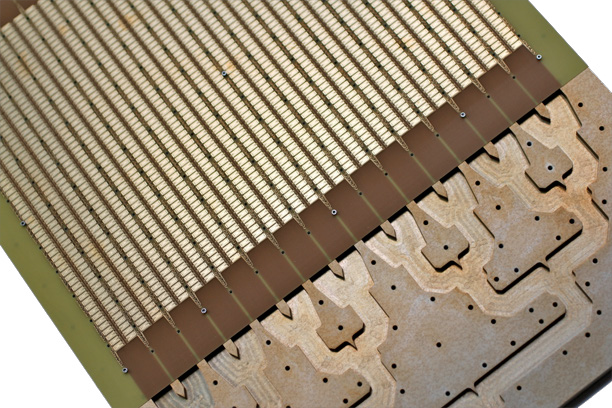In the early 2000s, in a Duke University laboratory, a team of researchers began to explore ways to commercialize the application of a technology known as metamaterials. Just over a decade later, the satellite communications industry is seeing the benefits of this research.

Satellite antennas built using metamaterials technology are opening doors to new markets for the satellite communications industry and ushering in a new era of mobility. The technology will provide new communications solutions previously impossible with traditional satellite antennas.
The satellite communications industry, which has relied on a parabolic dish antenna infrastructure, is ripe for innovation. A tremendous variety of markets rely on the satellite industry to deliver connectivity around the planet, with users ranging from militaries to humanitarian groups, from maritime shipping lines to airlines and many more.
However, as the demand for broadband connectivity everywhere expands into highly mobile applications and requirements for higher bandwidth, new opportunities for forward-thinking innovators in the market are created.
Delivering Ubiquitous Broadband + Mobile Access
Ubiquity and mobility have been, and will continue to be, drivers of innovation for the satellite communications industry. While access ubiquity has long been the industry’s forte, it is increasingly the trend toward mobility that poses a challenge.
Parabolic satellite antennas have provided reliable fixed connectivity for years, but many industries are seeing an increase in demand for mobile connectivity and are, therefore, seeking less expensive, smaller solutions designed for delivering the new generation high-speed connectivity that customers expect. Just as consumers become more and more connected to smartphones, industries—including major airlines, among many others—are becoming more dependent on satellite technology to deliver seamless broadband access anywhere on the planet.
Furthermore, the ever-increasing consumption of online data, driven primarily by over-the-top (OTT) video on services such as Netflix and Hulu, presents an extraordinary opportunity for the satellite communications industry to deliver a solution that goes well beyond the reach of wired infrastructure.
As the world moves into the ever more challenging environment of mobile communications and the need to be connected anywhere, the ability to deliver high-speed, low-cost connectivity to new markets has the potential to be the underpinning of a major transformation of the communications industry.
Metamaterials + Satellite Communications
In the context of these trends, our firm, Kymeta, is developing new metamaterials-based flat panel antennas.
Many people are misled by the term “metamaterials,” and often ask to “see the metamaterial” itself. That is a misnomer, as the word refers to a field of study rather than to a singular piece of technology. Scientists have studied the application of metamaterials for more than 60 years, albeit without using the term itself, with research dating back to the 1940s.

Kymeta’s mTennaTM products simplify satellite connections needed for instant broadband service anywhere in the world, including mobile applications such as planes, trains, boats, and automobiles.
Metamaterials use man-made materials to modify the performance of the electromagnetic spectrum to elicit capabilities that were not previously possible in nature. With the backing of Intellectual Ventures in Seattle, Washington, Dr. Nathan Kundtz (who had been a key contributor to the research team at Duke University) began exploring specific uses of metamaterials technology to create antennas that are able to dynamically steer a radio signal without any moving mechanisms. Instead, these metamaterials-based satellite antennas take advantage of a software-controlled panel which is capable of tracking satellites across the sky without any repositioning of the physical antenna.
These antennas are able to deliver the beam-steering performance of a traditional phased array antenna without expensive and power-hungry phase shifting components. The Kymeta antennas consume only a few watts of power—as opposed to phased array antennas of equivalent size that typically consume more than thousand watts.
The reductions in size, cost, power consumption and increased portability made possible by this technology open up a number of markets for the industry where traditional satellite antennas were difficult to integrate or have had particular disadvantages. As metamaterials-based technology continues to mature, interest in its potential is growing rapidly in a number of industries with a stake in improved connectivity.
For example, flat, unobtrusive satellite antennas are a natural fit for the aeronautics industry as commercial airlines seek to provide higher levels of broadband Internet connectivity for passengers. We have an agreement in place with Inmarsat Global Xpress that was signed last March to build Kymeta antenna prototypes for commercial aircrafts. Similarly, the luxury yacht market, long plagued by bulky satellite antenna domes visible on top of the most sleekly designed yachts in the world, can benefit from smaller, low-profile satellite antennas that are essentially invisible on the yachts.
Another compelling use of this technology is in the delivery of broadband access to previously unreachable or underserved parts of the world. Our recently announced agreement with O3b Networks aims to develop beam steering fixed satellite antennas which track O3b’s non-geosynchronous satellites as they move across the sky.
What’s Next For Metamaterials?
The commercialization of metamaterials technology isn’t without challenges. Like any new technology, there are obstacles to its acceptance and integration into established markets. When pioneering a new technology in any industry—from pharmaceuticals to 3D printing—many dynamics are at play.
Incumbent technology-makers often feel challenged, though in the case of metamaterials, applications lie largely in the gaps that incumbent technology cannot fill. However, the evolving needs of the marketplace, evident in trends toward ubiquity and mobility, have created significant demand for new satellite communications solutions from the industry and its customers. This has meant that obstacles to mainstreaming metamaterials-based technology are far outweighed by widespread industry excitement over the technology’s potential.
One particularly exciting use of this technology is in the field of personal connectivity. Kymeta is developing a Portable Satellite Terminal roughly the size of a laptop computer that would enable true portability and satellite connectivity where such has not been possible before. We are fond of saying that these portable terminals are capable of delivering VSAT-type performance, with uplink data rates up to 2Mbps and downlink data rates up to 20Mbps, at BGAN size.
Additionally, as the use of Internet-enabled devices, particularly mobile smartphones, becomes more commonplace around the world, there will be increasing demand for connectivity in remote and developing parts of the world. While metamaterials-based satellite receivers may not be suited for integration directly with smartphones, we’re encouraged by the work of our partners Inmarsat and O3b Networks to expand broadband connectivity around the globe.
Automotive manufacturers have also taken notice of the potential of metamaterials-based satellite antennas. The automotive market represents an incredible opportunity for the satellite communications industry, as manufacturers look for new, more efficient systems to deliver critical firmware and software updates to cars on the move, as well as to power the infotainment systems becoming commonplace in automobiles. There are also opportunities to integrate metamaterials-based technology into personal communications inside the home, where flat-panel satellite antennas have clear applications for entertainment and broadband access.
The desire for innovative satellite communications solutions is evident in the excitement around the development of these metamaterials-based antennas. Organizations in industries including aeronautics, maritime and land transportation, energy and mining, global aid agencies and more have all expressed interest in the technology. A new era of metamaterials-based satellite antennas means access to new markets that were previously unavailable and a more sustainable future for the satellite
communications industry.
For 20-plus years, satellites have beamed critical data to many parts of the world beyond the reach of wired infrastructure, but oftentimes the cost and power needs of satellite receivers was prohibitive to creating truly ubiquitous connectivity, while the size requirements of most antennas prohibited significant mobility in satellite communications.
With these new solutions based on metamaterials technology beginning to emerge, we envision an industry that will continue to deliver leadership in bringing far-reaching broadband communications to the world over. With new, portable and less expensive antennas, we are poised to see a communications ecosystem where being connected, anywhere, is a reality.
For further information about metamaterials and Kymeta, please access the company website at this direct link: http://www.kymetacorp.com/

About the authors
Vern Fotheringham has been a serial entrepreneur in the broadband wireless and satellite communications industry for over 25 years. He has created and built numerous successful ventures and contributed to large scale projects for major service providers, system vendors and software solution suppliers. He has also been a public policy and regulatory advocate for new telecommunications service rules and standards, and an inventor and creator of now globally adopted standards, innovative new products and services. Previously he was the President and CEO of ADAPTIX, Inc., a world leader in the development of the OFDMA technology that is now the core of the Mobile WiMAX and LTE broadband radio systems.
Dr. Kundtz has an M.S. in electrical engineering and a Ph.D. in physics from Duke University. Dr. Kundtz has authored or co-authored numerous peer-reviewed publications in the field of metamaterials and beam forming antennas. His research has centered on the application of advanced concepts such as transformation optics to real needs and benchmarking the performance of such devices.

